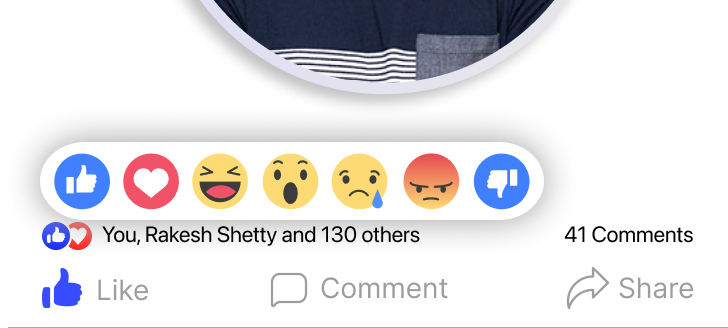Flutter交互反馈插件reaction_button的使用
Flutter交互反馈插件 reaction_button 的使用
reaction_button 是一个用于构建社交媒体应用程序的可定制反应按钮插件。它允许用户对内容进行点赞、评论等操作,并提供视觉反馈。
Features 特性
- 可定制的反应按钮,适用于构建社交媒体应用。
- 支持多种反应类型(如点赞、赞、笑等)。
- 提供了默认的图标和文本显示,也可以自定义。

Usage 使用方法
基本用法
在你的 Flutter 项目中引入 reaction_button 插件后,可以通过以下代码创建一个反应按钮:
ReactionButton(
selectedReaction: postModel.selectedReaction,
onChangedReaction: (reaction) {
setState(() {
postModel.selectedReaction = reaction;
});
},
placeHolder: ReactionModel(
value: 'like',
initialView: const Image(
width: 32,
image: AssetImage(AppAssets.LIKE_ACTION_ICON),
),
selectedView: const Row(
children: [
Image(
width: 32,
image: AssetImage(AppAssets.LIKE_ICON),
),
Text('Like'),
],
),
),
reactions: reactions,
)
完整示例 Demo
下面是一个完整的示例代码,展示了如何在 Flutter 应用中使用 reaction_button 插件:
import 'package:flutter/material.dart';
import 'package:reaction_button/reaction_button.dart';
// 假设 AppAssets 和 FeedData 已经定义好
import 'app_assets.dart'; // 包含 LIKE_ACTION_ICON 和 LIKE_ICON 路径
import 'feed_data.dart'; // 包含 posts 列表
import 'post_model.dart'; // 包含 PostModel 类
import 'reaction_data.dart'; // 包含 reactions 列表
void main() {
runApp(const MyApp());
}
class MyApp extends StatelessWidget {
const MyApp({super.key});
@override
Widget build(BuildContext context) {
return MaterialApp(
title: 'Reaction Button Demo',
theme: ThemeData(
colorScheme: ColorScheme.fromSeed(seedColor: Colors.deepPurple),
useMaterial3: true,
),
home: const MyHomePage(title: 'Home Page'),
);
}
}
class MyHomePage extends StatefulWidget {
const MyHomePage({
super.key,
required this.title,
});
final String title;
@override
State<MyHomePage> createState() => _MyHomePageState();
}
class _MyHomePageState extends State<MyHomePage> {
@override
Widget build(BuildContext context) {
return Scaffold(
appBar: AppBar(
backgroundColor: Theme.of(context).colorScheme.inversePrimary,
title: Text(widget.title),
),
body: Center(
child: Column(
mainAxisAlignment: MainAxisAlignment.center,
children: <Widget>[
Expanded(
child: ListView.builder(
itemCount: posts.length,
itemBuilder: (BuildContext context, int index) {
PostModel postModel = posts[index];
return Card(
child: Padding(
padding: const EdgeInsets.all(10),
child: Row(
children: [
Text('${postModel.id}'),
ReactionButton(
selectedReaction: postModel.selectedReaction,
onChangedReaction: (reaction) {
setState(() {
postModel.selectedReaction = reaction;
});
},
placeHolder: ReactionModel(
value: 'like',
initialView: const Image(
width: 32,
image: AssetImage(AppAssets.LIKE_ACTION_ICON),
),
selectedView: const Row(
children: [
Image(
width: 32,
image: AssetImage(AppAssets.LIKE_ICON),
),
Text('Like'),
],
),
),
reactions: reactions,
),
Text('${postModel.id}'),
],
),
),
);
},
),
),
],
),
),
);
}
}
注意事项
- 依赖管理:确保在
pubspec.yaml文件中添加reaction_button依赖:dependencies: flutter: sdk: flutter reaction_button: ^latest_version # 替换为最新版本号
更多关于Flutter交互反馈插件reaction_button的使用的实战系列教程也可以访问 https://www.itying.com/category-92-b0.html
1 回复
更多关于Flutter交互反馈插件reaction_button的使用的实战系列教程也可以访问 https://www.itying.com/category-92-b0.html
当然,下面是一个关于如何在Flutter中使用reaction_button插件来实现交互反馈的示例代码。reaction_button插件通常用于创建具有视觉和触觉反馈的按钮,以增强用户体验。
首先,确保你已经在pubspec.yaml文件中添加了reaction_button依赖:
dependencies:
flutter:
sdk: flutter
reaction_button: ^x.y.z # 请替换为最新版本号
然后,运行flutter pub get来安装依赖。
接下来是一个完整的示例代码,展示了如何使用reaction_button:
import 'package:flutter/material.dart';
import 'package:reaction_button/reaction_button.dart';
void main() {
runApp(MyApp());
}
class MyApp extends StatelessWidget {
@override
Widget build(BuildContext context) {
return MaterialApp(
title: 'Reaction Button Demo',
theme: ThemeData(
primarySwatch: Colors.blue,
),
home: Scaffold(
appBar: AppBar(
title: Text('Reaction Button Demo'),
),
body: Center(
child: ReactionButtonExample(),
),
),
);
}
}
class ReactionButtonExample extends StatefulWidget {
@override
_ReactionButtonExampleState createState() => _ReactionButtonExampleState();
}
class _ReactionButtonExampleState extends State<ReactionButtonExample> {
ReactionType reactionType = ReactionType.like;
void handleReaction(ReactionType type) {
setState(() {
reactionType = type;
});
// 这里可以添加你的逻辑,比如更新UI或发送数据到服务器
print("Reaction type: $reactionType");
}
@override
Widget build(BuildContext context) {
return Column(
mainAxisAlignment: MainAxisAlignment.center,
children: <Widget>[
Text(
'Tap the button below to give feedback',
style: TextStyle(fontSize: 20),
),
SizedBox(height: 20),
ReactionButton(
onReaction: handleReaction,
initialReaction: reactionType,
buttonColor: Colors.blue,
iconColor: Colors.white,
size: 80.0,
borderRadius: 20.0,
reactions: [
Reaction(
type: ReactionType.like,
icon: Icons.thumb_up,
),
Reaction(
type: ReactionType.dislike,
icon: Icons.thumb_down,
),
Reaction(
type: ReactionType.wow,
icon: Icons.sentiment_very_satisfied,
),
Reaction(
type: ReactionType.sad,
icon: Icons.sentiment_dissatisfied,
),
Reaction(
type: ReactionType.laugh,
icon: Icons.laugh,
),
Reaction(
type: ReactionType.heart,
icon: Icons.favorite,
),
],
),
],
);
}
}
在这个示例中:
- 我们创建了一个名为
MyApp的应用,其中包含一个Scaffold,Scaffold中有一个AppBar和一个居中的ReactionButtonExample组件。 ReactionButtonExample是一个有状态的组件,它维护了一个reactionType状态,用于跟踪用户选择的反馈类型。handleReaction方法在用户点击按钮时被调用,并更新reactionType状态。ReactionButton组件配置了多种反馈类型(如点赞、不喜欢、惊叹、悲伤、大笑和心形),并设置了按钮颜色、图标颜色、大小、边框半径等属性。
运行这个示例,你将看到一个具有多种反馈选项的按钮。每次点击按钮时,按钮上的图标会根据用户的选择进行更新,并且会在控制台中打印出用户选择的反馈类型。








